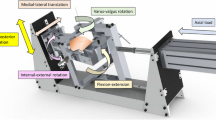Abstract
Purpose
Posterior capsular contracture is a potential consequence of osteoarthritis, post-traumatic arthritis, and surgical procedures of the knee. Many patients who undergo TKA will be found to have some degree of flexion contracture intraoperatively, which necessitates posterior capsular release. There is no information in the literature about the safety of posterior capsular release done during TKA. The present cadaveric study investigates the safety of posterior capsular release during TKA.
Methods
This study involved ten fresh-frozen cadaver specimens, each of which underwent three successive releases of the posterior capsule medially, laterally, and in the midline. One senior joint surgeon performed this procedure with a 1.27 cm curved osteotome, hugging the bone posteriorly on the distal aspect of the femur until the osteotome moved freely behind the bone without resistance. The distance from the distal aspect of the femur to the tip of the osteotome was then measured. Finally, the popliteal fossa was dissected, and the course of the neurovascular bundle was followed to assess for any macroscopic injury.
Results
The capsule was penetrated at a median depth of 13.6 cm (range 10.3–17.6). Even at this depth, no injuries to the popliteal artery, tibial nerve, or popliteal vein occurred in any of the 30 penetrating events.
Conclusion
This study suggests that posterior capsular release can be performed safely with this technique.


Similar content being viewed by others

References
Bellemans J, Vandenneucker H, Victor J, Vanlauwe J (2006) Flexion contracture in total knee arthroplasty. Clin Orthop Relat Res 452:78–82
Cloutier JM, Sabouret P, Deghrar A (1999) Total knee arthroplasty with retention of both cruciate ligaments. A nine to eleven year follow-up study. J Bone Jt Surg Am 81(5):697
Dean CS, Chahla J, Mikula JD, Mitchell JJ, LaPrade RF (2016) Arthroscopic posteromedial capsular release. Arthrosc Tech 5(3):495–500
DeHaven KE, Cosgarea AJ, Sebastianelli WJ (2003) Arthrofibrosis of the knee following ligament surgery. Instr Course Lect 52:369–381
Hube R, Mayr HO, Pfitzner T, von Roth P (2015) Management of flexion contracture in primary total knee arthroplasty. Z Orthop Unfall 153(3):328–330
Lindenfeld TN, Wojtys EM, Husain A (2000) Surgical treatment of arthrofibrosis of the knee. Instr Course Lect 49:211–221
Nichols JS, Ashford RU (2013) Surgical anatomy and pathology of the popliteal fossa. Ortho Trauma 27(2):113–117
Okamoto Y, Nakajima M, Jotoku T, Otsuki S, Neo M (2016) Capsular release around the intercondylar notch increases the extension gap in posterior-stabilized rotating-platform total knee arthroplasty. Knee 23(4):730–735
Scuderi GR, Kochhar T (2007) Management of flexion contracture in total knee arthroplasty. J Arthroplasty 22(4):20–24
Tanzer M, Miller J (1989) The natural history of flexion contracture in total knee arthroplasty: a prospective study. Clin Orthop Relat Res 248:129–134
Tardy N, Thaunat M, Sonnery-Cottet B, Murphy C et al (2016) Extension deficit after ACL reconstruction: is open posterior release a safe and efficient procedure? Knee 23:465–471
Tew M, Forster IW (1987) Effect of knee replacement on flexion deformity. J Bone Jt Surg Br 69(3):395–399
Werner BC, Cancienne JM, Miller MD, Gwathmey FW (2015) Incidence of manipulation under anesthesia or lysis of adhesions after arthroscopic knee surgery. Am J Sports Med 43:1656–1661
Funding
No external funding was used.
Author information
Authors and Affiliations
Corresponding author
Ethics declarations
Conflict of interest
On behalf of all authors, Sameer Naranje states that there is no conflict of interest.
Ethic approval
All procedures performed in studies involving human participants were in accordance with the ethical standards of the institutional research committee and with the 1964 Helsinki declaration and its later amendments or comparable ethical standards.
Additional information
Publisher’s Note
Springer Nature remains neutral with regard to jurisdictional claims in published maps and institutional affiliations.
Rights and permissions
About this article
Cite this article
Pinter, Z., Staggers, R., Lee, S. et al. Open posterior capsular release with an osteotome in total knee arthroplasty does not place important neurovascular structures at risk. Knee Surg Sports Traumatol Arthrosc 27, 2120–2123 (2019). https://doi.org/10.1007/s00167-019-05399-1
Received:
Accepted:
Published:
Issue Date:
DOI: https://doi.org/10.1007/s00167-019-05399-1



